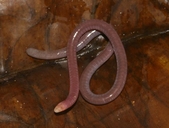|
Microcaecilia marvaleewakeae Maciel & Hoogmoed, 2013
| family: Siphonopidae genus: Microcaecilia |
| Species Description: Maciel AO, Hoogmoed MS 2013 A new species of Microcaecilia (Amphibia: Gymnophiona: Siphonopidae) from the Guianan region of Brazil. Zootaxa 3693: 387-394. | |
|
Etymology: This species is named in honor of Dr. Marvalee H. Wake, professor of the Department of Integrative Biology, University of California, Berkeley, and important researcher of caecilians (Maciel and Hoogmoed 2013). |
|
 © 2013 Ricardo Alexandre Kawashita-Ribeiro (1 of 2) |
|
|
|
Description At over 123, Microcaecilia marvaleewakeae has more primary annuli than M. albiceps, M. grandis, M. rabei, M. savagei, M. trombetas, M. unicolor, M. iyob, and M. dermatophaga. Microcaecilia marvaleewakeae has more primary grooves and maximum complete secondary grooves than M. dermatophaga at 9 and 3, respectively. Conversely, M. marvaleewakeae has fewer primary scales and secondary groves than M. supernumeraria at a maximum of 143 and 93, respectively. Microcaecilia marvaleewakeae’s fewer than 42 secondary grooves distinguish it from M. grandis and M. rochai, and its bicuspid rather than monocuspid vomeropalatine teeth set it apart from M. albiceps, M. savage, M. supernumeraria, M. trombetas, and M. unicolor. Microcaecilia marvaleewakeae differs slightly from M. taylori due to a greater maximum of 138 rather than 130 primary grooves. Additionally, M. marvaleewakeae has a higher maximum number of secondary grooves and complete secondary grooves at over 20 and 6, respectively (Maciel and Hoogmoed 2013). In life, the body is reddish-pink or dark lavender. The skin has a translucent-like sheen. The face becomes increasingly light- and yellow-colored approaching the anterior end. Areas around the vent, as well as lateral annular grooves, are lighter-colored as well. Preserved specimens are a pale yellow with a significant gray or brown tone. Lateral and ventral portions of preserved bodies are slightly lighter than the rest, with annular grooves slightly darker (Maciel and Hoogmoed 2013). Current specimens are very anatomically consistent. Some specimens lack a dorsal transverse groove on the first collar. Furthermore, one of the most geographically-isolated specimens has five more primary annuli than others in the species, but fewer secondary grooves (Maciel and Hoogmoed 2013). Distribution and Habitat Country distribution from AmphibiaWeb's database: Brazil
Known specimens have been collected within the municipalities of Urucará and Oriximiná, in the states of Amazonas and Pará, Brazil, respectively. Specimens were all collected in forested areas at elevations of 50 to 160 meters (Maciel and Hoogmoed 2013). Life History, Abundance, Activity, and Special Behaviors Small, immature ova with abundant fat bodies are present on the holotype organism (Maciel and Hoogmoed 2013). However, there is currently no information on the reproductive behavior of M. marvelwakeae. Trends and Threats Comments No genetic analysis has been done yet, but the species is suspected to be most closely related to M. taylori as they are morphologically very similar (Maciel and Hoogmoed 2013, Wilkinson et al. 2013).
References
Maciel, A. O., and Hoogmoed, M. S. 2013. A new species of Microcaecilia (Amphibia: Gymnophiona: Siphonopidae) from the Guianan region of Brazil. Zootaxa 3693: 387–394. Wilkinson, M., Sherratt, E., Starace, F., Gower, D. J. (2013). ''A New Species of Skin-Feeding Caecilian and the First Report of Reproductive Mode in Microcaecilia (Amphibia: Gymnophiona: Siphonopidae).'' PLoS ONE, 8(3), 1-11. Originally submitted by: Axel C. Hauduc (first posted 2015-10-09) Comments by: Hong Nguyen (updated 2024-12-18)
Edited by: Ann T. Chang (2024-12-18) Species Account Citation: AmphibiaWeb 2024 Microcaecilia marvaleewakeae <https://amphibiaweb.org/species/8038> University of California, Berkeley, CA, USA. Accessed Jun 14, 2025.
Feedback or comments about this page.
Citation: AmphibiaWeb. 2025. <https://amphibiaweb.org> University of California, Berkeley, CA, USA. Accessed 14 Jun 2025. AmphibiaWeb's policy on data use. |


 Map of Life
Map of Life